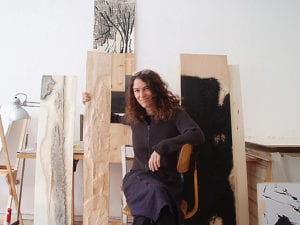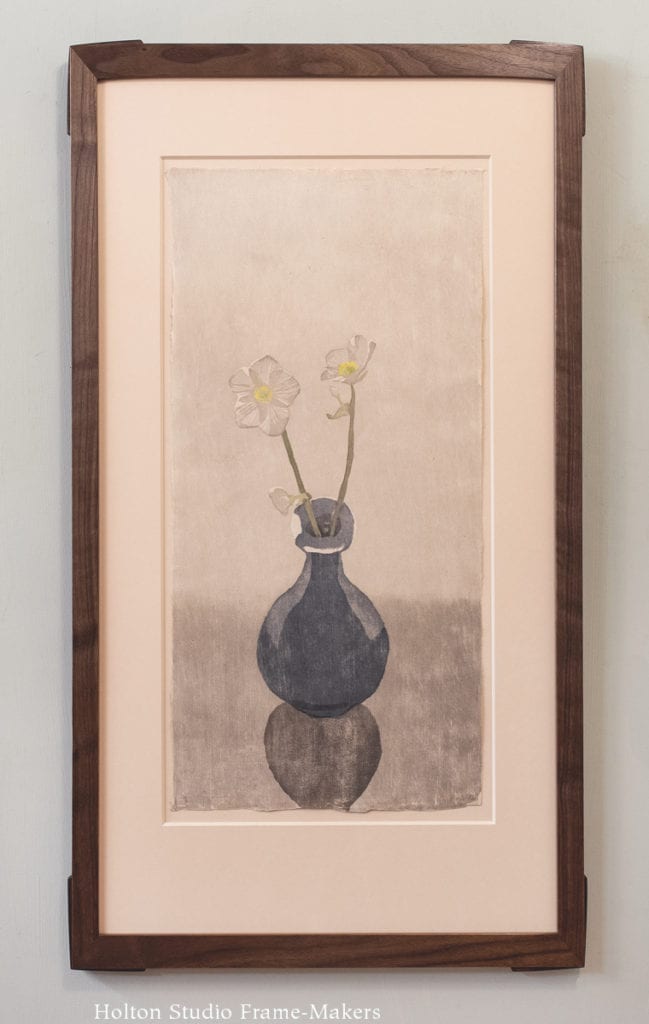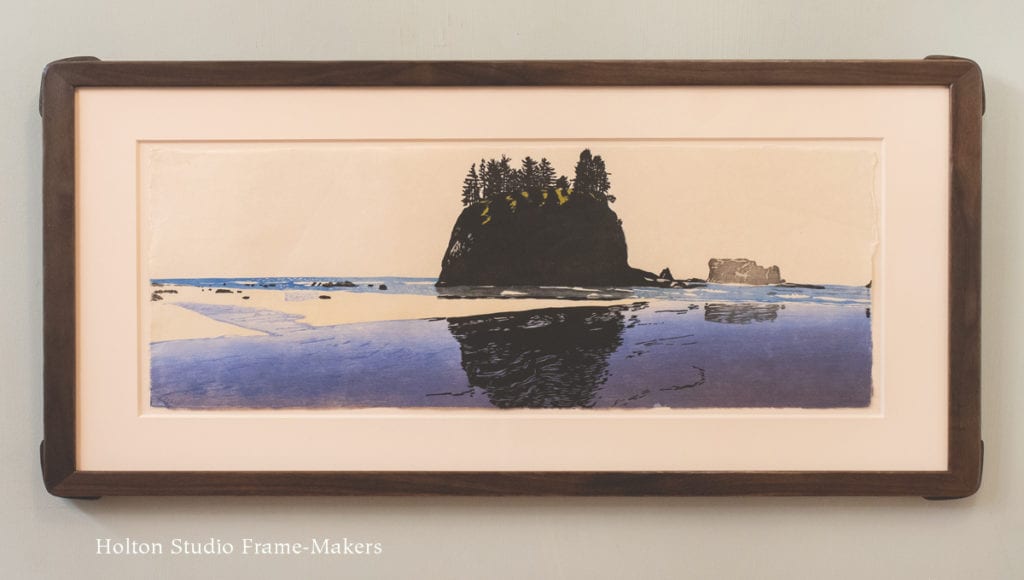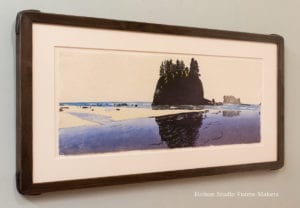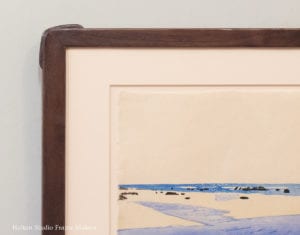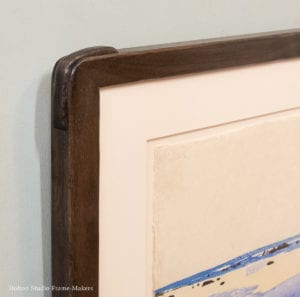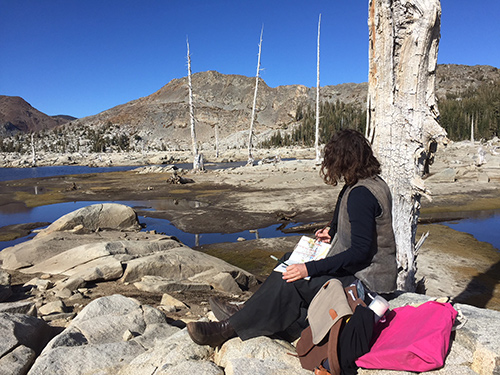We just framed three prints by an outstanding contemporary German printmaker, Eva Pietzcker. These prints are examples of her work using the Japanese woodblock technique (mokuhanga) which involves water-based inks, and therefore results in the more muted effects associated with watercolor.
Residing in Berlin, Pietzcker has studied papermaking and printmaking in China and Japan and traveled widely, including to the west coast of the United States. Two of the prints here draw on subject matter from those latter trips.
I’ve been doing more with proud splines, and two of these works inspired me to explore that technique. All three prints, being in elongated formats, use what I’m calling altered miters, joining two adjacent sides in different widths and thus requiring a miter at something other than 45 degrees. All three frames are stained walnut.
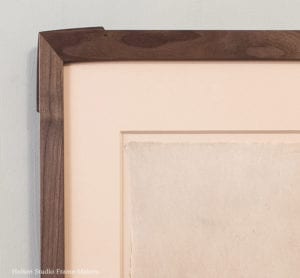 This first example, shown above, is “Christmas Roses.” As with all three works, we floated the 24-3/4″ x 12″ print in the window of an 8-ply rag mat to expose the deckled edges of the handmade paper. The frame’s sides are 1″ wide, the top and bottom members 1-3/8″. The proud splines are shaped to a form harmonious with the forms of the print. The ends of the top member are slightly curved. (See corner detail at right.) The print is simple and masterfully subtle. The trick for me was to frame it in a manner consistent with that subtlety. That might, to some, have meant no detail at all—a minimalist treatment. But as logical as that sounds, it would not have actually been alive to—effected by—the print’s character, including its subtly interdependent, contrasting and harmonizing forms.
This first example, shown above, is “Christmas Roses.” As with all three works, we floated the 24-3/4″ x 12″ print in the window of an 8-ply rag mat to expose the deckled edges of the handmade paper. The frame’s sides are 1″ wide, the top and bottom members 1-3/8″. The proud splines are shaped to a form harmonious with the forms of the print. The ends of the top member are slightly curved. (See corner detail at right.) The print is simple and masterfully subtle. The trick for me was to frame it in a manner consistent with that subtlety. That might, to some, have meant no detail at all—a minimalist treatment. But as logical as that sounds, it would not have actually been alive to—effected by—the print’s character, including its subtly interdependent, contrasting and harmonizing forms.
The 9-1/2″ x 26-1/2″ print “La Push,” above, is very similarly framed, but the rugged forms and their rough and irregular edges seemed to me to call for some carving. So the frame, otherwise flat, has carved inner and outer edges, and the shaped proud splines are also carved. The top and bottom members are 7/8″ wide, the sides 1-1/4″.
Carving is also the main feature of the frame on “Fallen Leaf Lake,” 13″ x 38″, below.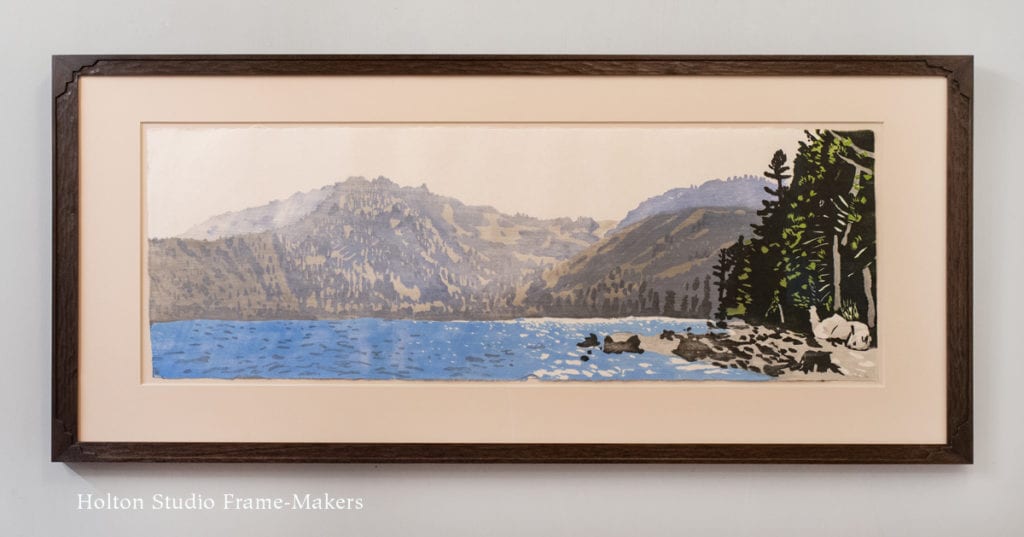
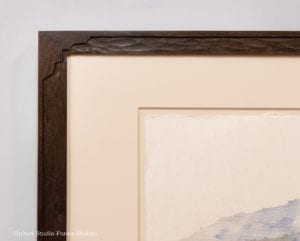 It has 1″ top and bottom members and 1-3/8″ sides. We didn’t use proud splines, but did carve the corners in exactly the same fashion that the woodblock itself is carved—with a flat high surface, which, on a woodblock, would be inked.
It has 1″ top and bottom members and 1-3/8″ sides. We didn’t use proud splines, but did carve the corners in exactly the same fashion that the woodblock itself is carved—with a flat high surface, which, on a woodblock, would be inked.
The altered miters are a natural adaptation to the form of the picture and should feel natural and not attract attention to themselves. Conventional frame shops are rarely equipped to execute and provide this simple and obvious feature, but it is easy enough for the ordinary woodworker’s or joiner’s shop to do.
One of the first principles of frame-making is to find a harmony between the art of the frame and the art of the picture. Because both frame-making and woodblock printing entail wood and its shaping, that harmony comes especially naturally.
In the U.S., Eva Pietzcker is represented by Davidson Galleries (Seattle).
« Back to Blog
